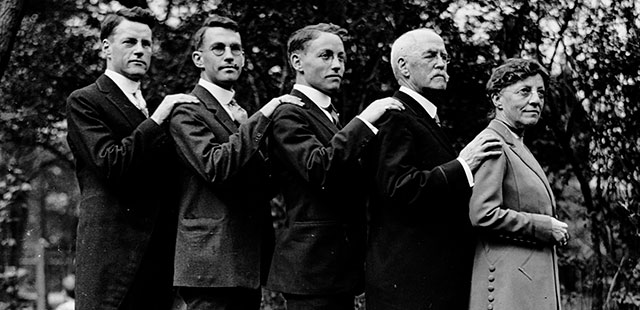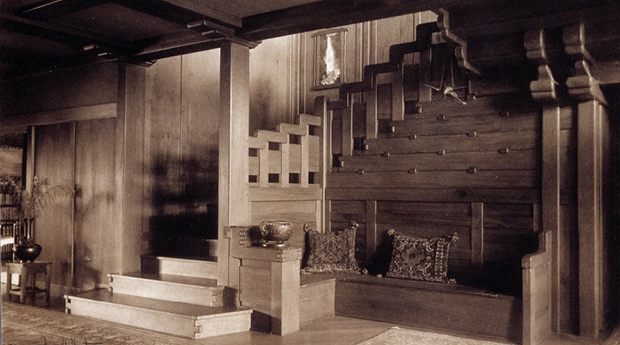
David and Mary Gamble with their three sons, left to right: Cecil, Sidney, and Clarence. Photo © Greene & Greene Archives, Gamble House.
The Gamble House was designed in 1908 by architects Greene & Greene. It was commissioned by David and Mary Gamble, of Cincinnati, Ohio, as a winter residence.
David Berry Gamble, a second generation member of the Procter & Gamble Company in Cincinnati, had retired from active work in 1895, and with his wife, Mary Huggins Gamble, began to spend winters in Pasadena, residing in the area’s resort hotels. By 1907, the couple had decided to build a permanent home in Pasadena. In June of that year, they bought a lot on the short, private street, Westmoreland Place, passing up the more fashionable address, South Orange Grove, known at that time as “Millionaires’ Row.”
At the same time the Gambles were selecting their lot on Westmoreland Place, a house designed by the firm of Greene & Greene was being built for John Cole on the adjacent property. Perhaps meeting the architects at the construction site, and certainly impressed with the other Greene & Greene houses in the Park Place neighborhood, the Gambles met with the brothers and agreed on a commission.
The architects worked closely with the Gambles in the design of the house, incorporating specific design elements such as the family crest among its motifs. Drawings for the house were completed in February 1908, and ground was broken in March. Ten months later, the house was finished, the first pieces of custom furniture were delivered, and The Gamble House became home to David Gamble, his wife Mary, and their youngest son Clarence. (Their oldest son Cecil was already working for Procter & Gamble; their middle son Sidney had just started at Princeton University.) Mary’s younger sister, Julia, also came to live with the family. By the summer of 1910, all the custom-designed furniture was in place.
David and Mary lived in the house until their deaths in 1923 and 1929, respectively. Cecil Huggins Gamble and his wife Louise Gibbs Gamble began living in the house after Julia’s death in 1944, and briefly considered selling it. They soon changed their minds, however, when prospective buyers spoke of painting the interior teak and mahogany woodwork white! The Gambles realized the artistic importance of the house and it remained in the Gamble family until 1966, when it was deeded to the city of Pasadena in a joint agreement with the University of Southern California School of Architecture.

